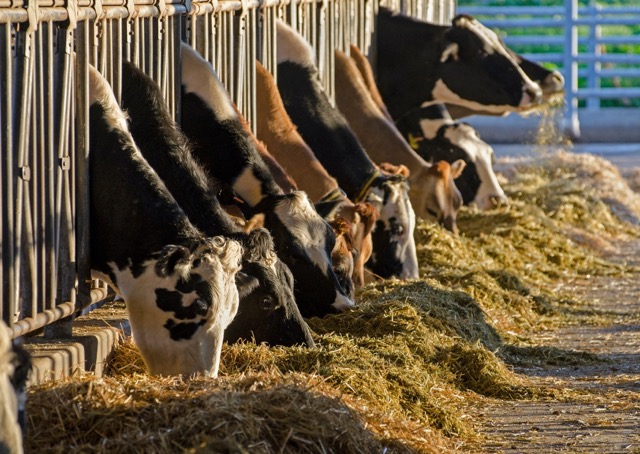Managing feed costs in volatile markets
Feed is consistently one of the biggest costs on livestock farms. For many UK dairy units, purchased feed makes up 30–40% of total milk production costs, while in beef systems, feed and forage can account for more than half of variable costs. That means movements in global markets quickly affect farm profitability.
With margins already under pressure from rising energy, fertiliser, and labour costs, it has never been more important to understand what is driving feed prices — and how you can respond on farm.
The current market picture
Global trends influencing feed prices
Soya prices have recently risen on the Chicago futures market, driven by optimism around renewed US–China trade talks and expectations that China may resume US soyabean purchases.
This potential increase in demand comes as oil prices rally sharply on the back of US sanctions on Russian oil companies.
However, whether this rally continues remains uncertain. In Brazil, farmers are planting the new crop, and with planting 22% complete by mid-October, there are currently no concerns.
The US Department of Agriculture forecasts a Brazilian soyabean crop of 175 million tonnes, an increase of 6 million tonnes from the previous season. With this crop due for harvest in early 2026, we may see prices begin to ease — or at least stabilise — as global supply builds.
On the grain side, large wheat crops from Russia, Europe, and Australia are keeping wheat markets bearish, while a significant maize crop from the US adds further downward pressure.
Overall, while there has been a short-term rally in protein, the fundamentals for grains and oilseeds remain comfortable — but that doesn’t mean we should be complacent about feed costs.
How this affects your farm
Any increase in feed costs has a direct impact on cost of production. But the effects go beyond finance -ration balance, cow health, and environmental performance are also at stake.
Financial: Even a small rise in protein costs can add several pence per litre to milk production costs. For beef finishers, higher purchased feed bills reduce margins per kilo of liveweight gain.
Nutritional: Cutting back on protein without balancing energy and fibre can compromise milk yield, growth rates, and fertility.
Sustainability: Imported protein carries a higher carbon footprint. Rising costs increase the incentive to explore alternatives and make better use of homegrown feeds.
What farmers can do in response
While no one can control global commodity markets, there are practical steps every farm can take to reduce exposure and make feed go further.
1. Maximise the value of forage
Good quality forage is the cheapest feed available. A well managed silage clamp can save thousands of pounds compared to relying on purchased feeds.
- Carry out regular forage analysis so rations are based on actual nutrient values
- Focus on clamp management to minimise spoilage – seal clamps properly, remove silage evenly, and avoid secondary fermentation
- Target milk from forage as a key performance indicator
2. Balance rations carefully
When protein prices rise, getting the energy to protein ratio right is more important than ever.
- Avoid overfeeding protein – this increases costs without delivering yield benefits
- Ensure enough effective fibre is present to maintain rumen health and avoid acidosis
- Work with a nutritionist to model different ration scenarios – small changes can reduce reliance on purchased protein without affecting performance
3. Minimise feed waste
Wasted feed is wasted money. Losses often occur before feed even reaches the cow.
- At the clamp: keep faces tight, use shear grabs, and avoid leaving loose silage exposed
- During mixing: ensure mixer wagons are calibrated so ingredients are accurate
- At the feed barrier: push up feed regularly, avoid overfilling, and maintain clean troughs
Even a 5% reduction in feed waste can deliver meaningful cost savings across a winter.
4. Explore alternative protein sources
Rising soya and rapemeal prices increase the value of alternative protein feeds. Options such as distillers’ grains, beans, or lupins can sometimes provide cost-effective substitutes.
However, availability, storage, and ration balance must be considered carefully. Not all alternatives will suit every system.
5. Monitor cow performance closely
Regularly track milk yield, butterfat, protein, body condition score, and feed conversion efficiency. If performance dips, it may be more cost-effective to adjust the ration than to simply increase purchased feed.
6. Keep track of market prices
Feed markets move quickly, so regular monitoring is essential. Sign up for updates from trusted sources such as AHDB, or work with a feed trader who provides daily or weekly price information. Having access to current market data helps you make informed purchasing decisions and avoid buying at peaks.
Promar’s role in feed cost management
By combining these on-farm actions with informed market insight, farmers can take a more proactive approach to feed cost management.
At Promar, we work with farmers across the UK to translate market trends into practical on-farm actions. Our consultancy support includes:
- Forage testing and analysis to identify the true value of homegrown feeds
- Ration planning tailored to herd requirements, forage stocks, and milk contracts
- Feed efficiency benchmarking to compare performance and highlight savings
- Alternative feed strategies that reduce reliance on volatile imported proteins
- Sustainability advice on reducing carbon footprint while protecting margins
Feed costs will always fluctuate, but with the right planning, efficiency, and support, their impact can be managed.
To understand what’s driving your feed costs and build a strategy that protects your margins, contact us today on 01270 616800.







